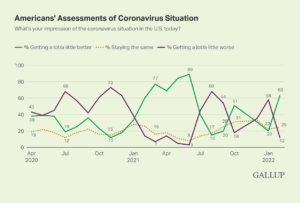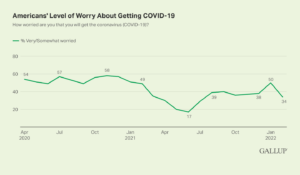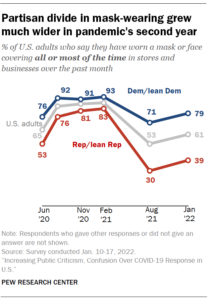Americans are feeling a whole lot better about the COVID-19 pandemic and are more willing to venture out to places they shied away from for the past two years, according to new data published by both Gallup and Pew Research Center.
This development has direct bearing on churches, which currently stand their best chance since the start of the pandemic to get people back in the physical pews.
Remember that wave of optimism that swept the country in May and June 2021, as vaccines became commonplace, and it appeared the pandemic threat was waning? And remember how short-lived that hope became as the Delta variant and then the Omicron variant swept the globe anew?

The good news today, by comparison, is that Americans today are more optimistic about the trajectory of the pandemic than they have been since those halcyon days after vaccines and before Delta and Omicron.
“As COVID-19 infections, hospitalizations and deaths continue to decline, Americans’ concern about contracting the disease has dropped precipitously,” according to a new report from Gallup based on polling done Feb. 12-23.
Highlights of this new poll show:
- The percentage of Americans who say the situation is getting better has more than tripled to 63%.
- Pessimism about the direction of the pandemic has fallen 46 percentage points to 12%.
- The percentage saying the situation is staying the same has remained relatively constant at 25%.
- The 63% of U.S. adults now expressing positivity about the direction of the pandemic is the highest since last June after the vaccine was rolled out and infections were down sharply, but it is well below the 89% recorded then.
- 55% of U.S. adults are still worried about future variants, and two-thirds expect the pandemic will persist through the end of 2022 or beyond.
 Gallup reports: “As Americans have become more likely to say the pandemic is improving, fewer have indicated they are worried that they will get COVID-19. One in three Americans, 34%, are now worried that they will contract the virus, including just 6% who are ‘very worried’ and 28% ‘somewhat worried.’ This is down from 50% in January but similar to the late November/early December 38% reading and is the lowest for the measure since July 2021. Currently, 38% are ‘not too worried’ and 28% ‘not worried at all.’”
Gallup reports: “As Americans have become more likely to say the pandemic is improving, fewer have indicated they are worried that they will get COVID-19. One in three Americans, 34%, are now worried that they will contract the virus, including just 6% who are ‘very worried’ and 28% ‘somewhat worried.’ This is down from 50% in January but similar to the late November/early December 38% reading and is the lowest for the measure since July 2021. Currently, 38% are ‘not too worried’ and 28% ‘not worried at all.’”
One specific area of concern remains high, however: “Parents’ concern that their children will be infected with COVID-19 continues to be higher than adults’ worry about being infected themselves.”
In the February poll, 45% of parents said they are very (15%) or somewhat (30%) worried about their kids contracting the virus — the same percentages as recorded in late November/early December before the height of Omicron infections.
Gallup’s data are confirmed by new polling reported by Pew Research Center, which says: “Two years after the coronavirus outbreak upended life in the United States, Americans find themselves in an environment that is at once greatly improved and frustratingly familiar.”
Pew highlights a much more nuanced perspective than the Gallup numbers indicate.
 “For the public, the sense of optimism that the country might be turning the corner — evident in surveys shortly after President Joe Biden took office and as vaccines became widely available — has given way to weariness and frustration,” the Pew report says. “A majority of Americans now give Biden negative marks for his handling of the outbreak, and ratings for other government leaders and public health officials have tumbled. Amid these criticisms, a growing share of Americans appear ready to move on to a new normal, even as the exact contours of that new normal are hard to discern.”
“For the public, the sense of optimism that the country might be turning the corner — evident in surveys shortly after President Joe Biden took office and as vaccines became widely available — has given way to weariness and frustration,” the Pew report says. “A majority of Americans now give Biden negative marks for his handling of the outbreak, and ratings for other government leaders and public health officials have tumbled. Amid these criticisms, a growing share of Americans appear ready to move on to a new normal, even as the exact contours of that new normal are hard to discern.”
On the sunny side, Pew notes:
- About three-fourths of U.S. adults now report being fully vaccinated.
- Teens and children as young as 5 are now eligible for vaccines.
- The national unemployment rate has plummeted from nearly 15% in the first weeks of the outbreak to around 4% today.
- A large majority of K-12 parents report that their kids are back to receiving in-person instruction.
- Sporting events, concerts and other big events are once again drawing crowds.
But on the cloudy side, Pew’s researchers remind that the virus has claimed the lives of more than 950,000 Americans.
“The staggering death toll of the virus continues to rise, with nearly as many Americans lost in the pandemic’s second year as in the first, despite the widespread availability of vaccines. The economic recovery has been uneven, with wage gains for many workers offset by the highest inflation rate in four decades and the labor market roiled by the Great Resignation. The nation’s political fractures are reflected in near-daily disputes over mask and vaccine rules. And thorny new societal problems have emerged, including alarming increases in murder and fatal drug overdose rates that may be linked to the upheaval caused by the pandemic.”
 And also on the cloudy side: Partisan divisions over masks and vaccines and the nature of the virus itself are more stark than ever. “The partisan divides that became so apparent in the first year of the pandemic did not subside. If anything, they intensified and moved into new arenas.”
And also on the cloudy side: Partisan divisions over masks and vaccines and the nature of the virus itself are more stark than ever. “The partisan divides that became so apparent in the first year of the pandemic did not subside. If anything, they intensified and moved into new arenas.”
There is a common thread running through these disagreements, Pew researchers noted: “Republicans remain fundamentally less concerned about the virus than Democrats, despite some notable differences in attitudes and behaviors within each party. In January, almost two-thirds of Republicans (64%) said the coronavirus outbreak has been made a bigger deal than it really is. Most Democrats said the outbreak has either been approached about right (50%) or made a smaller deal than it really is (33%).”
As the official beginning of a third year of the pandemic rolls around next week, “Americans increasingly appear willing to accept pandemic life as the new reality,” the Pew report explains. “Large majorities of adults now say they are comfortable doing a variety of everyday activities, including visiting friends and family inside their home (85%), going to the grocery store (84%), going to a hair salon or barbershop (73%) and eating out in a restaurant (70%).”
And as with the Gallup data, Pew pollsters found Americans are, in many ways, resigned to the reality of life with COVID ever-present: “The public, for its part, appears to recognize that a swift return to life as it was before the pandemic is unlikely. Even before the Omicron variant tore through the country, a majority of Americans expected that it would be at least a year before their own lives would return to their pre-pandemic normal. That included one-in-five who predicted that their own lives would never get back to the way they were before COVID-19.”
Related articles:
Charitable giving bounces back in 2021 but more for secular than sacred causes
Younger and older Americans aren’t returning to church as much as the middle-aged
Let’s stop the average Sunday attendance freak out | Opinion by Mark Tidsworth


